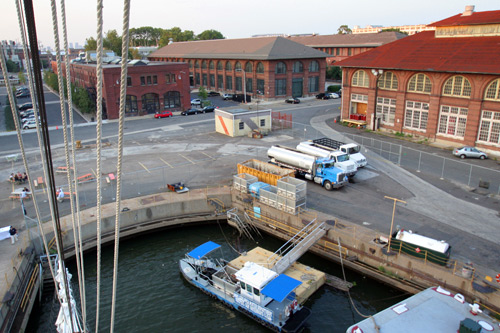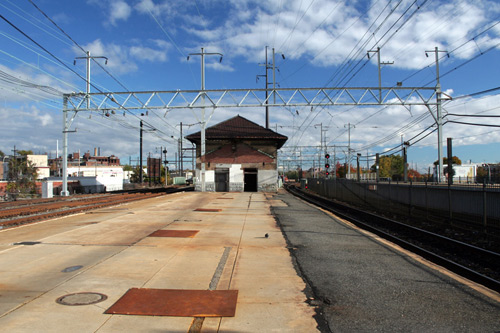1 April 08: The Possible City
Recess/Re-assess
|
by Nathaniel Popkin April 1, 2008  Inertia -- and Philadelphia's concentration of large education and medical institutions -- is keeping a lot of contractors employed right now. (This non-profit concentration, long seen as a sign of weakness in the local economy, may protect the city from the worst effects of the bust.) Quite a few small contractors are fat, but tired, from a decade of non-stop work; those who were smart enough to pick up a building or two along the way can finally get to work on them. Maybe the slower pace will improve the quality of workmanship. Some major construction projects, too far along to reel in, are moving forward. Others, architecturally-speaking among the most ambitious, are just being proposed. In this regard it's interesting to see how density works as a hedge against wider economic trends. The concentration of desires generates demand. This micro-economy signals global capital markets that there's money to be made here, hopefully making something like Winka Dubbeldam's UnKnot Tower possible. If that project moves forward it will tell us that as a brand Philadelphia has enough value to keep the steel rising. But Philadelphia the brand hasn't quite altered the reality of Philadelphia the poor city, perennially slow in recovering from recession. So we'd better keep a careful eye on how limited public resources are invested. The wrong moves will set us back five years; we'll start the next growth cycle behind, yet again. The right moves will keep the current momentum going. Given energy costs and likely changes in the political landscape, the second decade of the 21st century could be a good one for America's old cities; but Philly has to be ready to grow. There is an important difference between Philadelphia in 2008 and Philadelphia in 1988, at the eve of the last deep recession, and that is immigration. In 1988, few immigrants came here. That decade was the nadir for immigration in Philadelphia, marking the end of our city's descent from most to least cosmopolitan of any major city in the country. Post-recession, Philadelphia had to recover without the necessary injection of immigrant energy. That's like expecting a subsistence farmer to grow rich. Today the climate is substantially different. We've completed nearly two decades of relatively high immigration (now, the proportion of foreign born in Philadelphia is back above the 10% 1950 level); the impact is extraordinary. This outside capital (people, ideas, money) will help propel the city through the recession. But the economic downturn comes without change to immigration policy; together this has already reduced the number of foreign born entering the US. As anti-immigrant fervor tends to increase during a recession, we'll need to work harder to keep the doors open -- and people coming through them. The slowdown in private-sector investment also makes public sector spending proportionally more important. In order to ally with and magnify scarce private sector funds, government spending will have to be more careful and strategic. The Navy Yard is illustrative. In the 1990s, public money jump-started activity there. Then private companies invested their own money, getting us part-way there. Now it's time to leverage those billions. But there are two problems with the current strategy. The first is the instinct so far to conceive as the Navy Yard as following the form of suburban development; each project is its own discreet entity. The Yard itself is separate from the rest of the city; overall, despite the setting, it's little more than an employment center with acres of parking. The second, very much related, problem is that the Yard isn't capturing new economic activity; it's a transplant center for entities with space needs. So not only does the Yard create little of its own economy, it pulls from other parts of the city. (Hunting Park will feel the loss of Tasty Baking more than the Navy Yard will gain.) Strategic investment in infrastructure and transit, on the other hand, can integrate disparate parts of the Yard and connect the Yard itself with the rest of the city. Taken further, the Yard offers limitless potential for transformative and exciting infrastructure investment. The current, suburban mode is by definition limiting -- and ignores the Yard's strength, the river. The Navy Yard is tantalizing in part because it's an obvious strength we haven't yet exploited. The same could be said for the length of the Delaware waterfront, where shopping centers prevail, obliterating the urban potential. This is the critique that led to the Penn Praxis proposal for the central waterfront. The Praxis plan isn't perfect, but its central idea -- that value is derived from density and wasted by sprawl -- should govern public investment during this critical period. We face dumb, monolithic projects: the expansion of the Pennsylvania Convention Center and the two casinos. But public investment surrounding those projects means everything. The Convention Center expansion, so far bungled in every possible way, will be ruin if we do not imagine how to capture the Center's activity and integrate its functions with the city itself. Among other things, this might mean the thoughtful repositioning of public spaces on North Broad, connecting with and energizing those and in and around City Hall. As for the two casinos, the instinct to separate such derelict and confounding uses may be in error. It's unclear if the 1,500 foot ruling will prevail anyway. Assuming at the end of the day it doesn't, a better city planning strategy will be to masterfully integrate those casinos into the life of the city. Really doing so -- with transit, roadway changes, public space, good architecture -- could mean actually profiting from rather than bearing (without grinning) the crud and grim ambition of the gaming industry. I've mentioned transit about five times now. I do so because investing in transit shows a return -- and should therefore be a lead strategy in neighborhood development. Here again is an opportunity to build on a strength -- SEPTA ridership is up -- and to enhance the effect of density. What do I mean? Let's bundle transit improvements with investments in commercial areas of neighborhoods. The Wayne Junction station preservation project is case in point.  SEPTA is finishing early-stage plans for a $20 million station renovation, and this evening, the Philadelphia City Planning Commission hosts an open house on its Germantown and Wayne Junction Transit-Oriented Neighborhood Plan, along with its planning consulting firm Kise Straw and Kolodner. (The meeting is from 6:30 to 8:30 at First Presbyterian Church in Germantown, 35 W. Chelten Ave.) Make that investment meaningful and ultimately transformative by tying it to service improvements and investments in the streetscape. Fail to do so and consider Wayne Junction another wasted opportunity. In flush times we weather them (some other column I'll compose a troubling list of the decade's missed opportunities); in times of increasing scarcity, we have no such luxury. What we do now matters most of all. –Nathaniel Popkin nathaniel.popkin@gmail.com For more on The Possible City, please see HERE. For Nathaniel Popkin archives, please see HERE, or visit his web site HERE. |
|
• 7 Mar 08: "One-City Art Movement, Open to Everyone • 24 Feb 08: "Too late for the streetscape? • 15 Feb 08: "It really could be something." • 18 Jan 08: Estuary of Dreams • 11 Jan 08: More than shelter • 10 Jan 08: Nature's balance • 6 Dec 07: Snake uprising • 4 Dec 07: A Junction that ought to be • 6 Nov 07: Around the Mulberry Tree we go • 29 Oct 07: Wondering about wandering • 5 Oct 07: No other way • 21 Sept 07: Here is the Possible City |
